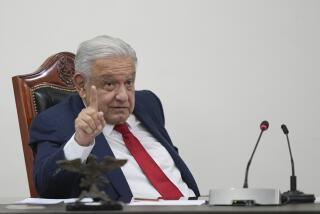Pope Cuts Tijuana From Mexico Itinerary : Religion: The 11-city tour is seen as a move to improve strained relations between Mexico and the church, and it is hoped that the prelate will address the migration issue.
- Share via
Vatican officials have scaled down Pope John Paul II’s scheduled trip to Mexico in May, canceling a number of planned stopovers, including a visit to Tijuana that many hoped would dramatize the plight of refugees and migrants.
Analysts have viewed the trip as accelerating a trend toward improvement in the long-strained relations between the Catholic Church and the government in Mexico, where constitutional provisions severely limit the church’s role in national affairs.
The final itinerary of the May 6-13 visit, according to a spokesman for Archbishop Girolamo Prigione, the Vatican’s delegate to Mexico, includes events in 11 cities, including a meeting with President Carlos Salinas de Gortari in Mexico City, a visit to a penitentiary in the north-central state capital of Durango and a liturgical celebration in a poor neighborhood of the southern city of Tuxtla Gutierrez. Also on the agenda are Aguascalientes, Veracruz, San Juan de los Lagos, Chihuahua, Monterrey, Villahermosa, Zacatecas and Chalco, site of a well-known shrine near Mexico City.
Last summer, church authorities released a preliminary itinerary that included Tijuana, Merida in the Yucatan and Acapulco on the Pacific Coast. But those were among a number of visits canceled to streamline the Pope’s schedule, a church official said.
“Tijuana was just too far,” said the spokesman for the apostolic delegate in Mexico City. “The problem is that Mexico is so big, and the Pope is already spending so much of his time traveling.”
Also cut were the central city of Puebla and the western city of Guadalajara, both of which were visited by the Pope on his last trip to Mexico, in January, 1979.
Church officials in Tijuana and other areas that were sliced from the agenda have expressed disappointment, but say they realize that the Pope cannot go everywhere in the nation of more than 80 million people, most of whom are Roman Catholics.
The specific themes to be addressed by the Pope during his visit remain unknown, although church officials have said he is expected to speak on topics ranging from Third World poverty, to drug trafficking, to foreign debt.
In Tijuana, which has become one of the world’s great migratory corridors, word of the Pope’s possible visit prompted expectation that he would discuss migration, particularly the flight of Latin American economic and political refugees to the United States. Tijuana is an intermediary destination for hundreds of thousands of migrants each year; it also attracts tens of thousands of settlers annually from elsewhere in Mexico.
Although the Pope will not visit Tijuana, it is still hoped that he will address the issue, so evident in Mexico and Central America, of people displaced for economic and political reasons.
“I’m sure the Pope will speak about migration,” said Sergio Bernardo Melendez, administrator of Centro Scalabrini, a church-run shelter in Tijuana that provides housing and other assistance to the city’s huge migratory population. “It would have been very interesting if he had come here, but I think whatever he says can help.”
Among other things, Melendez expressed hope that the Pope’s comments may prompt Mexican authorities to crack down on police and immigration officials who extort bribes from Central American migrants. “Maybe the Pope could help to reduce the exploitation of these people,” he said.
The hardships that propel immigration and the resulting rigors are not new themes for the pontiff. In January, he discussed the issue on a visit to Cape Verde, an impoverished archipelago nation off the West African coast that has a history of migration.
Whatever topics are addressed by the Pope in Mexico, his visit and meeting with Salinas are viewed as extremely significant in improving church-state relations. Mexican officials, their views shaped by revolutionary reforms dating from the 19th Century, have long been suspicious of the Catholic Church, an institution historically allied with conservative Latin American elites.
Salinas has indicated his desire to reach out to the church; he even invited members of the Catholic hierarchy to attend his inauguration in 1988. That and other developments have prompted hopes that the visit could result in reforms removing some of the more stringent legal limitations on the church in Mexico.
More to Read
Sign up for Essential California
The most important California stories and recommendations in your inbox every morning.
You may occasionally receive promotional content from the Los Angeles Times.













